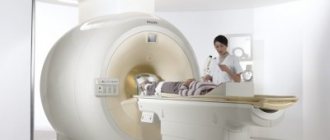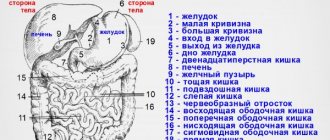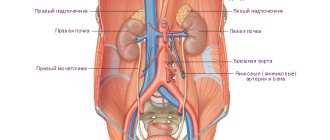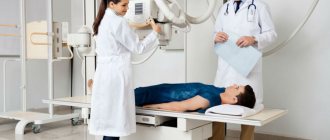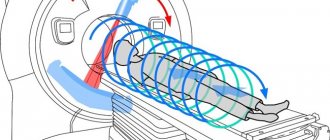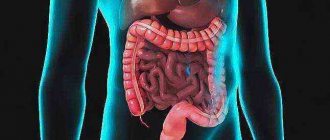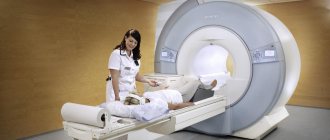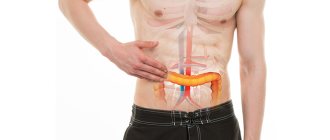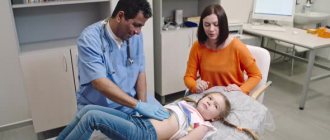Cholangiography is used by doctors to establish the patient’s health status, as well as to clarify emerging diseases. This method allows you to identify the disease at an early stage of its development. It would be useful for each person to learn about the indications and contraindications for the procedure, how dangerous it is, how to prepare for it, how much cholangiography costs in Moscow and other regions of the country.
Characteristics of the method
MRI with cholangiography is necessary for diagnosing the biliary tract, gallbladder and pancreas.
In medical practice, ultrasound and x-rays with cholangiography are used. However, the techniques are not so informative, and in the case of radiography, the fact of the adverse effect of X-rays on the human body cannot be ruled out.
With the help of MR cholangiography, the causes of previously unexplained disorders are clarified, and a reliable diagnosis is made if the development of severe or rare pathologies is suspected.
The examination is often prescribed by surgeons, therapists and gastroenterologists. During the research, layer-by-layer scanning of organs is carried out - the output is clear images of anatomical structures.
MRI
An additional diagnostic method is cholangiopancreatography (MRCP), a type of MRI that helps visualize the hepatobiliary and pancreatic systems in detail.
When is cholangiography prescribed?
Indications for the purpose of the study are:
- chronic pain in the right side;
- itching accompanied by yellow skin;
- disturbances in the outflow of bile;
- pain after injury;
- changes in biochemical blood test.
This method is used to monitor the treatment being carried out, as well as when simpler research methods do not allow an accurate diagnosis to be made for problems of the biliary system.
Indications for prescribing diagnostics
Magnetic resonance cholangiography is used in cases where the following disorders are suspected or monitored:
- the presence of stones (in the cavity of the gallbladder, ducts);
- formation of strictures (areas of narrowing of the ducts) - diagnosis is carried out when pathology develops in response to surgical intervention;
- the presence of developmental or vascular anomalies, gallbladder, ducts;
- stenosis of the major duodenal papilla;
- formation of partitions (kinks) in the gallbladder;
- formation of neoplasms and polyps in the local area;
- trauma or compression of the ducts;
- Klatskin tumor;
- pathological disorders of lymph nodes with blood vessels.
The technique diagnoses diseases at an early stage, and is applicable if it is necessary to pre-prepare the patient for surgery and evaluate the outcome of therapy.
MR cholangiography in St. Petersburg
There are no problems when the question arises - where to do MR-CPG? A special magnetic resonance examination is performed in any clinic in St. Petersburg that offers tomography services. The choice is quite large, but it is better to do the procedure in a trusted medical institution. On our website you can choose a clinic where experienced specialists will perform MR cholangiography using modern equipment: the price of the study is quite high, but quite affordable. Significant benefits of scheduling an examination include:
- the ability to select the optimal time for tomography;
- registration via the Internet around the clock;
- choosing the address closest to your place of residence where MR-KhPG can be done;
- savings due to cost reduction (discounts or promotions);
- no need to have a referral from a doctor.
Specialists at the MRI clinic will help you prepare for the examination, perform the procedure efficiently, and provide a qualified report in paper and electronic form. After this, all that remains is to see a doctor for treatment.
What are the advantages of tomography?
Below are the advantages of the diagnostic method:
- Accuracy of the technique. During the diagnostic process, not only the outline of individual organs is visualized, but also their sections. Each image has high resolution - a specialist determines the disorder at the initial stage of development without the use of additional tools. At the end of the procedure, the patient is given a disk with 3D graphics of the study area.
- Painless. Magnetic radiation used during scanning does not harm the patient's health. The procedure is not contraindicated for pregnant women and children.
- Non-invasive. During the diagnostic process, there is no need to violate the integrity of the skin.
When MRI cannot be performed
Among the strict contraindications to the examination:
- electronic devices, metal elements in the patient’s body;
- the patient's weight is more than 150 kg;
- the patient's inability to remain still;
- the circumference of the widest part of the body is more than 150 cm.
Relative restrictions on MRI diagnostics:
- pregnancy (1st trimester);
- patient age under 7 years;
- fear of confined spaces;
- decompensated heart failure;
- serious condition of the patient.
If we are talking about a contrast examination, contraindications for diagnosis include: pregnancy, lactation (you should avoid breastfeeding for 48 hours), some thyroid pathologies, kidney failure, and an allergic reaction to a contrast agent.
Advantages of cholangiography in MRI
If we compare other hardware methods for examining human internal organs, cholangiography has many advantages:
- Accuracy. During the study, not only the contours of organs are visualized from the inside and outside, but full sections of the bile ducts and gallbladder are created. There are a lot of pictures taken, and they have a high degree of resolution, which means it is possible to obtain detailed images. They can be viewed in different planes, and a 3D projection can be created. This way, errors in the results are minimized and a thorough study of a specific anatomical structure is ensured.
- Safety. The procedure is devoid of radiation exposure, unlike X-rays and ultrasound.
- Possibility of studying pregnant women and young children. Instead of X-ray radiation, a cholangiographic study uses a magnetic field, which does not have a negative effect on the patient’s health.
- Non-invasive. The procedure is carried out without penetration or insertion of any tubes, catheters or needles. Endoscopic examinations are often accompanied by side effects: gag reflex and injuries to the mucous membranes of the digestive tract. Thus, ERCP - endoscopic retrograde cholangiopancreatography - is the study of the bile ducts using X-rays, and they are first filled with contrast through a probe passing through the esophagus, stomach and duodenum. The procedure is unpleasant for the patient.
- No contrast. Unlike CT and some other types of MRI, cholangiography does not require the introduction of contrast agents, and this reduces the possibility of allergic reactions to the iodine contained in the drug.
Features of preparation for the procedure
Preparing the patient for the examination is short. Before an MRI, the patient is advised to abstain from food and liquids for 8 hours before the diagnosis.
Two days before the procedure, the patient should exclude from the diet foods that stimulate flatulence (legumes, white cabbage, black bread, etc.).
The doctor recommends giving up fatty foods, coffee, strong tea, and alcoholic beverages.
Immediately before the magnetic tomography scan, you can take an anti-gas medicine and do an enema.
The described recommendations should be followed to obtain reliable diagnostic data.
Indications and contraindications
Indications for MRI of the bile ducts are:
- nausea and vomiting;
- pain in the right hypochondrium or in the upper abdomen;
- jaundice;
- skin manifestations that indicate a violation of the secretion of bile or gastric juice;
- preparation for surgery, postoperative observation;
- surgery with damage to the bile duct;
- doubts regarding diagnosis;
- monitoring the effectiveness of treatment.
Despite the safety of the procedure, there are contraindications. MRI of the gallbladder should not be done for people with pacemakers, prostheses or any metal objects in the body, or for those with kidney failure.
During pregnancy, diagnostics are carried out only on the recommendations of a doctor. In the first trimester, it is advisable to refrain from examination.
When using a contrast agent, the list of contraindications expands. Diagnostics is prohibited in the following cases:
- allergy;
- pregnancy;
- Vorzast less than 7 years old;
- lactation;
- thyroid diseases;
- renal failure.
Before an MRI, the doctor must conduct an examination to identify chronic diseases in the patient.
Is contrast used during examination?
The type of diagnosis does not exclude the need to use a contrast agent, which helps to conduct a detailed study of the biliary system.
Such agents are non-toxic substances based on gadolinium (gadodiamide). Gadolinium salts are a liquid with a metallic composition.
The substance, when in contact with a magnetic field, clearly displays the area under study. After intravenous administration of the Omniscan drug, the component enters the liver and is excreted from the body along with bile.
During the process of contrast removal, it is possible to conduct a detailed diagnosis of the urinary ducts.
Carrying out MRI cholangiography
Magnetotherapy is carried out for no more than half an hour, you need to lie still. Otherwise, the procedure is no different from other types of therapy. During MRI, the patient must remove metal jewelry, removable dentures (metal), belts, and clothing with metal accessories. Afterwards, the patient is injected with a contrast agent intravenously. The patient is placed on a straight retractable table of the examination apparatus.
MR cholangiography is possible in closed and open type tomographs. The latter type is suitable for overweight people and pediatric patients. The open type may allow better interaction with the patient.
Progress of the survey
Before the examination begins, the patient removes metal elements, leaves electronic devices and changes into disposable clothing. The patient is placed on the moving table of the tomograph - the body is fixed with special belts at 3-5 points.
If necessary, a contrast agent is injected into the person and the accumulation of the composition in the local area is expected. The couch moves inside the tomograph - the equipment begins to work.
During the scanning process, the patient does not experience discomfort; the patient hears only the loud noise of the equipment. If necessary, the subject contacts the doctor using a button equipped inside the tomograph. During the diagnosis, the specialist will ask the patient not to breathe for 10-15 seconds.
How is magnetic resonance cholangiography performed?
The patient must leave any items that contain metal outside the manipulation room. If contrast enhancement is necessary, a gadolinium-based drug is injected through a catheter. Next, the patient must lie on the tomograph table, which will be moved into the tunnel. If necessary, special belts are used to secure the person in a stationary position. The scan will take 20 minutes without contrast, 30-35 minutes with gadolinium. During the examination, the patient must hold his breath briefly (15-20 seconds).
Important! MR cholangiography is performed strictly on an empty stomach. The last meal is possible no earlier than 6 hours before the session. Drink water no later than 1 hour before the test.
Decoding the result
The diagnostician deciphers the results. The specialist’s conclusion is given to the patient an hour after the end of the examination. In particularly difficult cases, documents are transferred the next day.
The images can demonstrate inflammatory processes in the pancreas, liver disease, and biliary tract diseases.
The specialist visualizes stones in the gall bladder and other anatomical structures, tumor processes, polyps, diagnoses cirrhosis, hepatitis.
Diagnostic value of MR cholangiography
The availability of magnetic resonance diagnostics opens up wide opportunities for early detection and selection of effective therapy for diseases of the liver, pancreas and biliary tract. Using the MR cholangiography procedure, you can:
- find out the exact location and anatomical features of the biliary system, which will be the best prevention of dangerous complications during surgery;
- quickly and accurately determine the cause of obstructive jaundice, without wasting time using several options for instrumental diagnostics;
- screen for complications in the early postoperative period;
- perform dynamic monitoring of the effectiveness of drug treatment as many times as the doctor needs to select the course duration of therapy.
Ultrasound scanning continues to be a screening method for detecting diseases of the liver and biliary tract, but if pathology is detected that requires surgical intervention, MRI is required to obtain complete and reliable information before surgery.
Cost of medical services
The average cost of an examination is 5,500 rubles. If additional diagnostics of the abdominal or retroperitoneal cavity is performed, the cost of the procedure is 11,500 and 13,000 rubles, respectively.
A contrast examination combined with diagnostics of the abdominal organs will cost 17,500 rubles. The cost of the scan includes a medical report drawn up by a specialist based on the information received.
Cholangiography is performed for a detailed diagnosis of the gallbladder, bile ducts and pancreas.
The procedure is often prescribed when rare or severe pathologies are suspected.
The advantages of the study are: non-invasiveness, painlessness and high information content.
During the diagnostic process, it is possible to use a gadolinium-based contrast agent. The type of MRI has a standard list of contraindications and provides for preparatory measures.
The cost of medical services depends on the scope of the scanning area and the type of tomography (contrast or non-contrast).
Contraindications for examination
Prohibitions on MRI of the abdominal organs are classified into absolute and relative (relative). The first category includes: medical implants that cannot be removed during the examination (pacemaker, metal clips installed on blood vessels, ear implants, Ilizarov apparatus, metal joint prostheses, permanent braces and crowns); obesity. The body weight of the subject should not exceed 130 kg.
Reminder to the patient before MRI cholangiography
Renal decompensation, gadolinium allergy, and pregnancy are complete contraindications for MRI cholangiography with contrast agent. Relative prohibitions on the procedure:
- cardiac decompensation;
- initial period of pregnancy (first trimester);
- mental pathology in the form of phobia of closed spaces;
- preschool age of the patient;
- inability to maintain a static position for the required period of time due to pain or convulsions.
Some relative contraindications can be eliminated with anesthesia. Anesthesia is used to keep the patient immobile or to relieve attacks of claustrophobia. The examination takes place in a hospital or specialized diagnostic clinic. The patient can choose where to have cholangiography done independently.
Source
Some patients may need an MRI of the abdominal cavity, in particular the biliary tract. Then the attending physician prescribes cholangiography with MRI. Anyone can be prescribed such an examination, so you should find out what kind of procedure it is and when it is prescribed, what contraindications exist, and what are the advantages of MRI with cholangiography.
